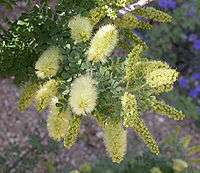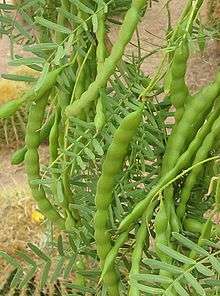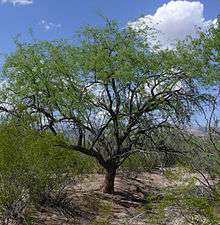Mesquite
Mesquite is a common name for several plants in the genus Prosopis, which contains over 40 species of small leguminous trees. They are native to the southwestern United States and Mexico (except the creeping mesquite, which is native to Argentina, but invasive in southern California). The mesquite originates in the Tamaulipan mezquital ecoregion, in the deserts and xeric shrublands biome, located in the southern United States and northeastern Mexico. The region covers an area of 141,500 km2 (54,600 sq mi), encompassing a portion of the Gulf Coastal Plain in southern Texas, northern Tamaulipas, northeastern Coahuila, and part of Nuevo León. As a legume, mesquite is one of the few sources of fixed nitrogen in the desert habitat.
 Screwbean pods.
Screwbean pods. Screwbean flowers
Screwbean flowers Honey mesquite, foliage with seedpods
Honey mesquite, foliage with seedpods Velvet mesquite dried seeds
Velvet mesquite dried seeds Velvet mesquite tree
Velvet mesquite tree- Honey mesquite foliage
This tree blooms from spring to summer. It often produces fruits known as "pods". Prosopis spp are able to grow up to 8 m tall, with regards to site and climate. It is deciduous and depending on location and rainfall can have either deep or shallow roots. Prosopis spp is considered long-lived because of the low mortality rate after the dicotyledonous stage and juveniles are also able to survive in conditions with low light and drought. The Cahuilla indigenous people of western North America were known to eat the seeds of mesquite. [1]
History
Prosopis spp has been in North America since the Pliocene era and its wood is dated 3300 yr BP.[2] It is thought to have evolved with megafauna in the New World. The loss of North American megafauna at the end of the Pleistocene era gave way to one theory of how the Prosopis spp was able to survive. One theory is that the loss of the megafauna allowed Prosopis spp to use its fruit pods to attract other organisms to spread its seeds; then with the introduction of livestock it was able to spread into grasslands. Another is that Prosopis spp had always been present in grasslands but recurring fires had delayed plant and seed development before the emergence of livestock and grazing.
Etymology
The English word mesquite is borrowed from the Spanish word mezquite, which in turn was borrowed from the Nāhuatl term mizquitl.[3][4][5]
Habit
Mesquite grows as a small shrub in shallow soil or as tall as 50 feet (15 m) in deep soil with adequate moisture and forms a rounded canopy nearly as wide. They may have one or multiple trunks with a multitude of branches. Mesquite has bipinnate leaflets of a light green to blue hue that cast a light to deep shade, depending on the species. Spikes of flowers form in spring and summer that form a flat pod of beans 2 to 6 inches (51 to 152 mm) long. Many varieties form thorns. When cut to the ground, the tree can often recover.
Uses

Once the pod is dry, the whole pod is edible and can be ground into flour and made into bread.
Mesquite is one of the most expensive types of lumber in the US. It was a popular type of wood used by early Spaniards to build ships, but is now used most commonly for high-end rustic furniture and cabinets.
Scraps and small pieces are used commonly as wood for cooking with smoke in southern states, and bring a premium on the market.
As an introduced and invasive species
Honey mesquite has been introduced to parts of Africa, Asia, and Australia and is considered by the World Conservation Union as one of the world's most problematic invasive species.[6] The spread into grasslands is mostly attributed to the introduction of domestic livestock, although other factors include climate change, overgrazing, and the reduction of fire frequency.[7] Although Prosopis spp is naturally occurring in these areas these changes have resulted in Prosopis spp being able to successfully outcompete other native plants and is now considered an invasive species due to the fact that it was able to take advantage of vulnerable ecosystems.[7]
Prosopis spp is different from most invasive species because it is highly invasive in its native range as well as introduced ranges. Its impacts on the invaded ecosystems include changes to hydrological, energy, and nutrient cycling, as well as consequences to biodiversity and primary production.[1] Prosopis spp density and canopy cover influence the herbaceous layer and native shrubs and are factors in the changes to the ecosystem.
In the United States, Prosopis spp has become the dominant woody plant on 38,000,000 hectares (94,000,000 acres) of semiarid grasslands. North America is its native range and due to an imbalance within this ecosystem has been able to spread rapidly. It is considered the most common and widely spread “pest” plant in Texas. It is estimated that about 25% of Texas’ grasslands are infested and 16 million acres are so invaded that it is suppressing the majority of grass production.[2] In Mexico and the US the two most problematic species are honey mesquite (Prosopis glandulosa) and velvet mesquite (Prosopis velutina). [7] Australia is also affected by the introduction of Prosopis spp, in particular, the P. pallida, P. glandulosa, P. velutina, and their hybrid P. juliflora. Prosopis spp is ranked nationally as one of the twenty most significant weeds. It now covers almost 1 million hectares of land. Prosopis spp was originally introduced to help with erosion because of its deep root system.[8] It also has immediate uses to humans through timber and providing a food source through its pods. Since Australia is a hot and semi-arid region, Prosopis spp has been able to become naturalized.
In India Prosopis spp had been introduced decades ago but it was not until recently that its effects had been studied. This plant species has been pushing out the Indian wild ass (Equus hemionus khur). [9] This herbivorous mammal eats the pods of Prosopis spp, which is one of the intended purposes of its introduction. Through digesting and excreting the seeds the Indian wild asses are providing the habitat needed for germination. The 5,000 square-kilometer Indian Wild Ass Sanctuary is experiencing mesquite invasion of roughly 1.95 square-kilometers a year. By overtaking the land, the dense canopy cover of Prosopis spp has made it so native vegetation cannot grow. It has also made watering holes inaccessible to the animals within this region. This lack of resources and range is forcing the endangered Indian wild ass into human landscapes and agriculture fields and locals are killing these asses in order to protect their crops.
Control strategies
Controlling Prosopis spp is a challenging task. One method that is often used is mechanical control. This can be effective with high mortality rates if stems are cut at least 20 cm underground. Another method is through the application of herbicides and this is done on an individual plant basis. Basal application is effective to Prosopis spp of all sizes while foliar application is best for plants smaller than 1.5 m. Another physical option for control is through fires. Some species of mesquite are fire sensitive while others are fire tolerant. For those that are fire sensitive this method can be highly effective but those that are fire tolerant require hot and intense fires to be effective. In Australia scientists are trying biological control methods. They have introduced multiple insects but the most effective in causing high population level impact is the leaf tying moth (Evippe spp).[10] The most recommended method for managing Prosopis, both in native and introduced ranges, is by targeting large amounts of plants either through herbicide or physical removal. There is also new research being done on using satellite and aerial images to assess canopy cover and determine which ranges should be targeted.[11]
Species
- Prosopis alba (white mesquite)
- Prosopis cineraria
- Prosopis chilensis (Chilean mesquite)
- Prosopis glandulosa (honey mesquite)[12]
- Prosopis humilis
- Prosopis juliflora
- Prosopis laevigata (smooth mesquite)
- Prosopis nigra (black mesquite)
- Prosopis pallida
- Prosopis pubescens (screwbean mesquite)
- Prosopis reptans (tornillo)
- Prosopis strombulifera (creeping mesquite)
- Prosopis velutina (velvet mesquite)
See also
References
- 1 2 Klinken, Rieks D. van; Graham, Jodi; Flack, Lloyd K. (2006-01-13). "Population Ecology of Hybrid Mesquite (Prosopis Species) in Western Australia: How Does it Differ from Native Range Invasions and What are the Implications for Impacts and Management?". Biological Invasions. 8 (4): 727–741. doi:10.1007/s10530-005-3427-7. ISSN 1387-3547.
- 1 2 Brown, J. R.; Archer, Steve (2013-03-13). "Woody plant invasion of grasslands: establishment of honey mesquite (Prosopis glandulosa var.glandulosa) on sites differing in herbaceous biomass and grazing history". Oecologia. 80 (1): 19–26. doi:10.1007/BF00789926. ISSN 0029-8549.
- ↑ Entry for mizquitl in the A Nahuatl–English Dictionary and Concordance to the Cantares Mexicanos by John Bierhorst (p. 216).
- ↑ Entry for mesquite in the Diccionario de la lengua española (Real Academia Española).
- ↑ Entry for mesquite in the Online Etymology Dictionary.
- ↑ "100 of the World's Worst Invasive Alien Species" (PDF). K-state.edu. Retrieved 2009-11-27.
- 1 2 3 "Mesquite ecology « Texas Natural Resources Server". Texnat.tamu.edu. Retrieved 2016-04-28.
- ↑ Cullen, Jim; Julien, Mic; McFadyen, Rachel (2012-03-05). Biological Control of Weeds in Australia. Csiro Publishing. ISBN 9780643104211.
- ↑ Platt, John R. "Mesquite Invasion Threatens a Unique Species in India". Scientific American Blog Network. Retrieved 2016-04-28.
- ↑ "Mesquite Management" (PDF). Weeds.org.au. Archived from the original (PDF) on 2016-03-26.
- ↑ Mirik, Mustafa; Ansley, R. James (2012-06-29). "Utility of Satellite and Aerial Images for Quantification of Canopy Cover and Infilling Rates of the Invasive Woody Species Honey Mesquite (Prosopis Glandulosa) on Rangeland". Remote Sensing. 4 (7): 1947–1962. doi:10.3390/rs4071947.
- ↑ "nature-mesquite". Texasbeyondhistory.net. Retrieved 3 October 2018.
External links
| Wikisource has the text of the 1879 American Cyclopædia article Mezquite. |
| Wikisource has the text of the 1911 Encyclopædia Britannica article Mesquite. |
- USDA NRCS Plants Database
- Honey mesquite, Screwbean mesquite, and Western mesquite at Texas A&M's Plant Answers
- Honey mesquite at the Texas Tree Planting Guide
- AgNews article on wood to ethanol using mesquite
- Mesquite Furniture Maker Directory
- Mesquite Roasted Coffee web site devoted to mesquite wood fire roasting of coffee
- Mesquite Local Business Directory
- Rogers, Ken E. (2000). The Magnificent Mesquite. University of Texas Press. ISBN 0-292-77105-3. OCLC 43036762.
- Casa de Fruta
- Mesquite Furniture